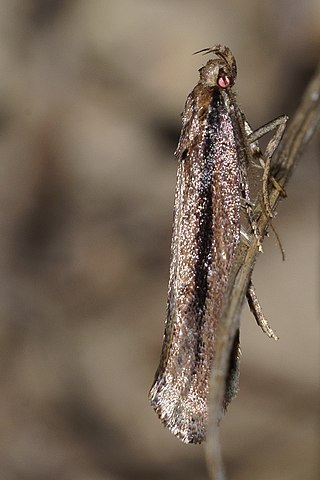
Amblyptilia epotis is a moth of the family Pterophoridae. It is endemic to New Zealand and is found in the South and Stewart Islands. It inhabits mountainous terrain covered in alpine vegetation or alternatively alpine wetland habitat. The adults of this species are on the wing from February to March. In appearance the adults of this species are variable in colour however this species can be distinguished from similar species by the oblique apical streak on its forewings as well as the patch of white on the costa cilia towards the apex of the forewing.

Ichneutica scutata is a moth of the family Noctuidae. It is endemic to New Zealand. This species can be found in the southern parts of the North Island as well as the eastern parts of the South Island. It is similar in appearance to I. insignis and I. skelloni but can be distinguished as I. scutata is much paler in appearance. It is likely this species inhabits lowland tussock grasslands as well as coastal dunes although it is not common in inland tussock grasslands. The larvae feed on a variety of herbaceous plants such as Plantago and Convolvulus species, Plagianthus divaricatus. It pupates on soil near its host plants. The adults are on the wing from late March to July.
Compsolechia tetrortha is a moth of the family Gelechiidae. It was described by Edward Meyrick in 1922. It is found in Peru and Amazonas, Brazil.
Compsolechia trapezias is a moth of the family Gelechiidae. It was described by Edward Meyrick in 1922. It is found in Brazil.
Idiophantis soreuta is a moth of the family Gelechiidae. It was described by Edward Meyrick in 1906. It is found in Sri Lanka.
Antaeotricha corvigera is a moth of the family Depressariidae first described by Edward Meyrick in 1915. It is found in Guyana and Peru.
Antaeotricha pactota is a moth of the family Depressariidae. The species was first described by Edward Meyrick in 1915. It is found in Guyana and Pará, Brazil.
Stenoma bicensa is a moth of the family Depressariidae. It is found in Brazil and Panama.
Chlamydastis synedra is a moth of the family Depressariidae. It is found in Paraguay.
Frisilia verticosa is a moth in the family Lecithoceridae. It was described by Edward Meyrick in 1914. It is found in southern India.
Frisilia rostrata is a moth in the family Lecithoceridae. It was described by Edward Meyrick in 1906. It is found in Sri Lanka.
Heteralcis palathodes is a moth in the family Lecithoceridae. It was described by Edward Meyrick in 1906. It is found in Sri Lanka.
Metathrinca illuvialis is a moth in the family Xyloryctidae. It was described by Edward Meyrick in 1914. It is found in Assam, India.
Metathrinca memnon is a moth in the family Xyloryctidae. It was described by Edward Meyrick in 1914. It is found in Sri Lanka.
Comotechna ludicra is a moth in the family Depressariidae. It was described by Edward Meyrick in 1920. It is found in Guyana.
Imma cyclostoma is a moth in the family Immidae. It was described by Edward Meyrick in 1906. It is found in Assam in India and Tanintharyi Region of Myanmar.
Imma dipselia is a moth in the family Immidae. It was described by Edward Meyrick in 1906. It is found on the Sulu Archipelago in the southwestern Philippines.
Imma epicomia is a moth in the family Immidae. It was described by Edward Meyrick in 1906. It is found on the Solomon Islands.

Tingena ancogramma is a species of moth in the family Oecophoridae. It is endemic to New Zealand and has been found in the Hen and Chicken Islands, the North Island and the South Island. Adults are on the wing in summer and autumn and inhabit open areas of forest scrubland.

Atomotricha versuta is a moth in the family Oecophoridae first described by Edward Meyrick in 1914. It is endemic to New Zealand and has been observed in both the North and South Islands. The adults of the species are variable in appearance but the three principal variteis are connected b intermediate forms. The female of the species is brachypterous and is incapable of flight. Both the adult male and female have been observed resting on fences during cold winter nights.



